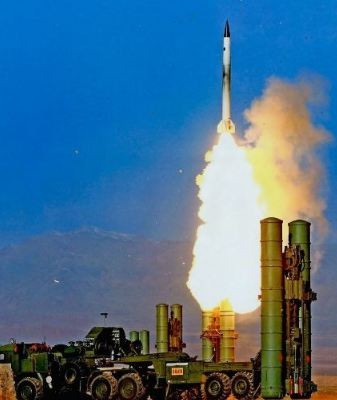Iran ended a massive three-day air defense exercise to warn the United States to stay away, and which it capped by firing missiles from its S-300PMU2 "Favorit" air defense missile system made in Russia it received in October.
The military exercise at the southern Persian Gulf region also saw indigenous surface-to-air missiles (SAM) such as Mersad (Ambush) "annihilate mock aggressive aircraft," (read U.S. aircraft), reported Iranian state-owned television.
Code named "Defenders of Velayat Skies 7," the war game covered the Persian Gulf provinces of Hormozgan and Bushehr along with the southwestern province of Khuzestan.
Iran's official IRNA news agency reported Islamic Republic of Iran Air Force (IRIAF) Air Defense Commander Brig. Gen. Farzad Esmaili saying the war game was held in an area covering 496,000 km.
Participants in the drill included the air defense forces of the IRIAF; the Islamic Revolutionary Guard Corps (IRGC); support units of the Navy of the Islamic Republic of Iran; the Islamic Republic of Iran Army and IRGC's ground forces artillery units, said Gen. Esmaili.
The exercises included around 17,000 military personnel and simulated intense and large-scale electronic warfare. It also sought to hone coordination among the different divisions of the armed forces employed to defend the country's airspace.
Iranian media also said IRIAF carried out the first operational test of the indigenous Sayyad-3 (Hunter-3) high-altitude SAMs paired with the Talash-3 (Struggle-3) medium-altitude SAMs system to hit aerial targets. IRIAF claims Talash can shoot down any hostile target, even at high altitudes.
IRIAF claims Sayyad-3 is capable of intercepting targets 150 km distant. It's combining Sayyad-3 with Talash, which is optimized for engaging medium altitudes targets.
This paired air defense system is guided by Ofoq (Horizon), a locally-manufactured fire control radar.
Media also revealed IRIAF warned several fighter jets and drones belonging to the U.S. Navy not to approach Iranian airspace during the military exercise. IRIAF also warned 12 aircraft from trans-regional countries to stay away from Iranian airspace.
Iran also tested a number of high-precision missiles and radar systeme in the military exercise, said Iranian media. These missiles were the Mersad and Ya Zahra-3 stationed at IRGC's Khatam al-Anbiya air defense base that detected, intercepted and destroyed mock airborne targets.
IRIAF said among the objectives of the air defense exercises was detecting and intercepting a hypothetical enemy's unmanned aerial vehicles (UAVs) using homegrown missile systems. Defensive mobile missiles systems were also successfully deployed to designated positions in record time, said IRIAF.
The drill also focused on intelligence gathering during reconnaissance missions and capturing aerial footage from maritime targets using reconnaissance drones.
Media said the exercise "set a record in the tactical mobility of armed forces, after the rapid deployment of radar and missile systems, artillery units, as well as communication and electronic warfare systems to the operation zone."
The S-300 missile system was built by Almaz-Antey, one of Russia's major makers of air defense systems and part of the Rostec group. Iran paid $1 billion for its S-300PMU2 system.
The sharp end of this surface-to-air missile (SAM) system is its Russian-made 48N6E SAM. These missiles have a maximum range of 150 kilometers and can reach a maximum altitude of 30 km.
The 48N6E is a vertical tube launched, solid fuel, single-stage, highly maneuverable SAM designed to shoot down aircraft, cruise missiles, UAVs and Theater Ballistic Missiles such as the U.S. THAAD with its high fragmentation warhead.
Its radars can operate amid electronic clutter and jamming. The system is fully automated, but manual observation and operation are also possible.
Each launcher vehicle carries four missiles with two missiles normally fired at one target within five seconds. A full battalion includes six launcher vehicles with a total of 24 missiles. It also includes command-and-control; long-range radar and engagement radar vehicles.
Iran, therefore, now has over 100 missiles at its disposal, excluding spares.



























